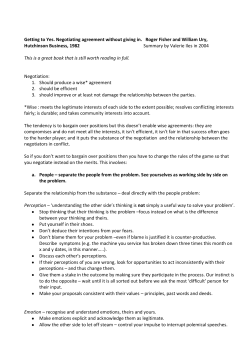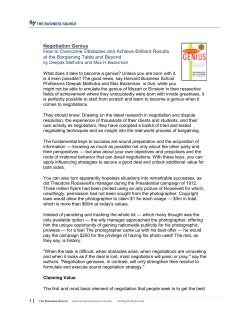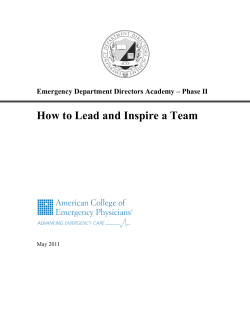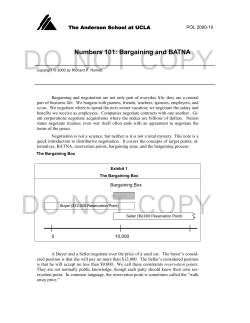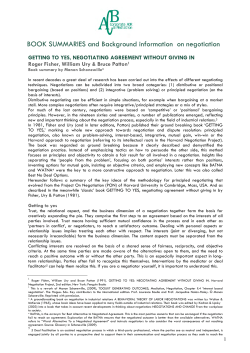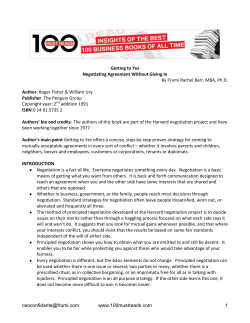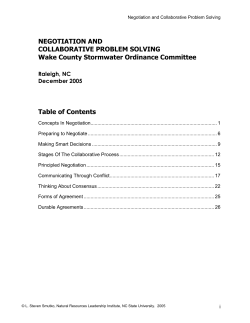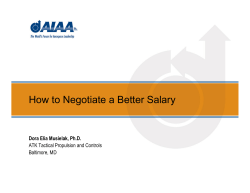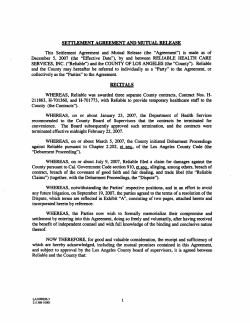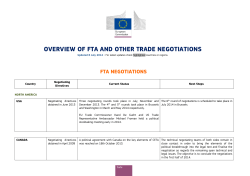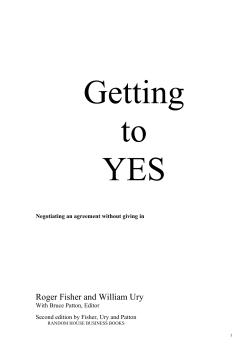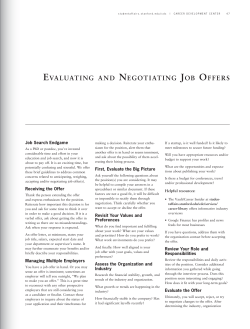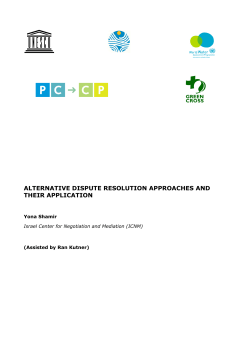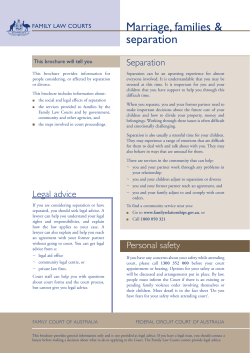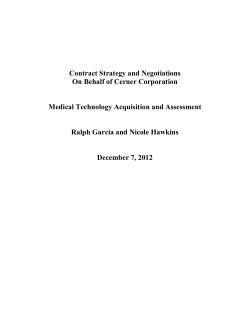
Rationalizing dispute resolution: From best alternative to the most likely... Wouter van Steenbergen Computer/Law Institute, Vrije Universiteit Amsterdam
Rationalizing dispute resolution: From best alternative to the most likely one Wouter van Steenbergen Computer/Law Institute, Vrije Universiteit Amsterdam Abstract In negotiation theory, the concept of knowing your BATNA plays an important role. Unfortunately, not much has been written about what should be considered a BATNA exactly. In this paper I will give more attention to how a BATNA should be established when the alternative to a negotiation would probably be a court procedure. Apart from that, I will show how having a good idea of your realistic alternatives can make negotiations more effective. 1 Introduction ‘What are my other options besides reaching an agreement with the other party?’ In negotiations, this will be a question that parties ask themselves many times. In any negotiation, a party should always keep in mind the possibilities he has left should an agreement not be reached. A project that aims to provide disputing parties with information about the alternatives to an agreement is the BEST-project (http://www.best-project.nl). The alternatives the project aims to present reflect what might be reached by means of a court procedure. Within the BEST-project we are striving to enable parties with a dispute about a tort act with information about their legal positions. The aim of this is to give parties the possibility to form themselves a judgment about whether they could hold another party liable for certain caused damage or if they could be held liable themselves. With this information, parties can determine how much room for negotiation is available when settling the damage. The reason it is important that parties have a realistic view of their position in the negotiation, is that disputes are most frequently settled between parties themselves, rather than in court or with support of a (legal) expert. Ideally, at the beginning of the negotiations, parties have an idea of what the outcome could be if their dispute would be decided by a judge. If in particular an estimation of the time a court procedure may take and the money it may cost is added to what could be awarded in court, a party gets an idea about what, in his dispute, his BATNA (Best Alternative To a Negotiated Agreement) is, that is: the best result that can be reached should the negotiations fail. In this paper I will discuss the concept of BATNA (Fisher, Ury & Patton 1991, p. 91). In particular is addressed the role that the notion of BATNA might play in negotiations concerning damages caused by a tort, when the most probable alternative to negotiating is a court procedure. The paper is structured as follows. First, I will elaborate on BATNA’s. After that, several different approaches that have been made to BATNA will be discussed. And finally, I will come up with a recommendation of which of the several potential alternatives to a negotiated agreement should be used to attain the best results in a certain negotiation. 2 Best Alternative To a Negotiated Agreement Originally, BATNA was intended as a way for a less powerful party to avoid reaching an agreement with a more powerful party by making explicit the alternatives to reaching an agreement. If one party for instance has more money, the other party, being aware of his best alternative to an agreement, would be able to minimize the risk of entering an agreement that, given the other available options, should have been rejected. The concept of the BATNA, however, also seems to be significant for other situations than those in which there is a disproportion between the strength of the negotiating parties. Three steps have been identified that should be followed to develop a BATNA (Fisher, Ury & Patton 1991, p. 103): • Inventing a list of actions you might conceivably take if no agreement is reached. • Improving some of the more promising ideas and converting them into practical alternatives. • Selecting, tentatively, the one alternative that seems best. Example: Suppose a man has found a new job in another city than he lived before and wants to move there. He has found a house and has started the negotiations to go and live there. If his job starts soon, he might be in a hurry to find himself a new place. This decreases his number of alternative options to buying that house and therefore weakens his position in the negotiations; his BATNA would be better if he had more time. Now, before entering the negotiations, the man should think about what he would do if he and the vendor of the house would not reach an agreement. Would he be able to find another house he likes and can afford in a short time? Maybe it would be possible to rent a house for a short period of time and meanwhile look for another house? These are questions that only can be answered depending on the local house market. This raises a question on how realistic the man should make his BATNA. Of course, it’s possible that he would find another nice house at low cost within a week, but what would the chances be of that happening? Is it realistic to assume that and does such an assumption really improve his position in the negotiating process? This is an important objection to the concept of the BATNA: The quality of a BATNA in a specific case depends heavily on the subjective opinion of a person who might very well not be capable of estimating his alternatives. This objection is partly met by the second step that should be taken to develop your BATNA: converting the more promising ideas into practical alternatives. If the man that wants to buy a house goes to a real estate agency, he will be able to get an idea of the market and his chances of finding another place in time. But even then, there is a large risk of being overoptimistic and as a consequence of that, refusing to reach an agreement while it would have been better to do so. This psychological effect of rating your chances better than they actually are is also recognized by Fisher, Ury & Patton, who state that: ‘One frequent mistake is to see your alternatives in the aggregate’ (Fisher, Ury & Patton 1991, p. 100). Because of this, I think it is better not to look at a person’s best alternative to an agreement, but rather to look at the most probable alternative. In the past, there have been attempts to approach the alternatives to a negotiated agreement in a more realistic way. In the next paragraph, I will have a closer look at these attempts. 3 3.1 Different approaches to the alternative to a negotiated agreement Estimated alternative to a negotiated agreement Negotiating parties will not always be aware of the realistic alternatives that are available to them. If that is the case, the negotiation will largely be determined by the expectations that the parties have of the available other options. Thus, in practice, this expectation plays a larger role in negotiations than the BATNA. A term that is distinguished by (Burgess & Burgess 2001) to describe the expectations that a party has about his alternatives, is the so-called Estimated or Expected Alternative To a Negotiated Agreement (EATNA). The problem with the EATNA is that many people will have unrealistic expectations about their alternatives. As stated before, it is a psychological phenomenon to be overoptimistic about your own chances (De Vries, Leenes & Zeleznikow 2005, p. 61-62), and more negative about the chances of others. When a party enters a negotiation with high expectations of other possibilities that he has apart from that negotiation, the chance of reaching an agreement decreases considerably. This is one of the reasons that attention has been given not only to the best existing alternatives when failing to reach an agreement, but also to the worst that could happen. 3.2 Worst alternative to a negotiated agreement To reduce the risk of a party being too optimistic about his alternatives and to help him make an informed decision, it has been argued one should not only analyse his BATNA, but also the Worst Alternative To a Negotiated Agreement (WATNA) (Notini 2005). So, in the example above, the man looking for a house should not only consider that he could find another place in a week if the negotiations don’t succeed (the best case scenario), but also the possibility that in a few months he still hasn’t found a decent place to live (the worst case scenario). Taking his WATNA into consideration might prevent him from rejecting an agreement he should have accepted. An objection to the WATNA can again be found in being too optimistic about one’s own chances. The same way people think they have better alternatives than actually is the case and underestimate the alternative of the other party in the negotiation, they will have a tendency to see their WATNA better than it is and assess the other side’s as worse than what would be realistic. 3.3 Most likely alternative to a negotiated agreement A third approach to the concept of BATNA is the Most Likely Alternative To a Negotiated agreement (MLATNA). In this approach it is not about the best or worst things that could happen if agreement has not been reached, but the most probable consequence is taken into consideration. What is most likely to happen if the negotiations are stopped determines when one should walk away from the negotiations? This seems to be the best approach to negotiating, because the other possible approaches are indifferent with regards to the probability of a certain scenario. If someone wants to know his BATNA, it makes quite a difference if the odds of him actually being able to realize this BATNA are 50% or 5%. If they are 50% he can easily reject an offer made to him that does not satisfy his BATNA being confident that he is able to attain better results with other parties. 4 4.1 What if the alternative is a court procedure? Differences from a ‘normal’ negotiation; difficulties As I already mentioned in the introduction, I will mainly focus upon establishing a realistic alternative to a negotiated agreement in the situation where someone has committed a tort and because of that caused damage to another party. Of course, in most cases, the damage will be insured and there will not be much discussion about who has to compensate the damage. I leave out the law suits and other negotiations between insurance companies. However, when the damage is not insured, negotiations about compensating can become quite difficult, largely because of some fundamental differences compared to a situation in which there does not exist a dispute between the negotiating parties. The most important ones can be summed up as follows. - The aim of both parties is not to create a win-win situation Usually, when two parties start a negotiation, they both have the feeling they could gain something by successfully ending the negotiation, both parties will benefit from it and thus create a win-win situation. Therefore, both parties will try to let the negotiation process run smoothly and act cooperative towards each other. Parties will occasionally be willing to give in on some points in order to eventually close a deal they personally benefit from. But, in the event that it turns out to be impossible to reach an agreement, both parties can go their separate ways and look for an alternative. This is totally different when the negotiations concerns damage compensation. The party that claims to have been caused damaged is aiming to get as much (financial) compensation for his suffered losses and will at least want the other party to admit to be liable for this damage. The other party will try to deny liability or at least try to keep the compensation as low as possible. As a result of these opposing interests, the tendency to rate one’s own BATNA too high and that of the other party too low, will be even greater than in the case of a ‘normal’ negotiation. This enlarges the gap that has to be bridged in the negotiation and makes it harder to reach a settlement. - There is a large amount of possible extra points of dispute Usually, in negotiations, the main issue to reach agreement over is the worth of a certain object. When we compare such a negotiation with a negotiation concerning damages caused by the act of a tort, the main issue here would be the exact amount of damage suffered (apart from the question whether the party that supposedly caused the damage can be held liable at all). But in the case of a tort this is not the only issue that needs to be settled. A lot of times, there will not only be disagreement over liability and the amount of damage, but also over what actually did happen: 1. Was it really party A who knocked over an expensive television at the reception? 2. And if so, wasn’t the organiser of the reception at least partly responsible for this damage because of the slippery floor and him neglecting to put a warning sign? 3. What does the law state about a situation like this? These are all points of discussion that complicate a case and the negotiations about a settlement with regards to damage compensation. They make it harder to predict a likely outcome of a court procedure and therefore to make a well-founded decision about whether to try and settle a dispute or to take it to court. - Emotion plays a much larger role in the negotiations When negotiating over a tort, mere damage compensation will not always be the only thing someone who has been caused damage is aiming for. Apart from that, he might want acknowledgement for the fact that he has been done wrong. On the other hand, the party that allegedly caused the damage might feel wrongly accused or feel to be approached overly aggressive. Not only does this complicate the negotiation between the disputing parties, it also makes it a lot harder to formulate an alternative to a negotiated agreement; what weight (if any) should be given to various non-monetary factors in the dispute? A lot of times, these non-monetary desires can’t be reached by a court procedure, which makes it quite hard to decide when it is time to try and attain an alternative to a negotiated agreement. 4.2 Establishing the different alternatives to a negotiated agreement We already saw that the negotiations in a dispute over a tort can involve quite some difficulties. Unfortunately, this is not only the case for the negotiations, but also for the alternative. When parties dispute over a tort and have trouble negotiating over the damage, the chances of them successfully going through a mediation procedure are quite small. The reason for this is the fact that in most cases parties will not have an already existing relationship and probably will not have a relationship in the future, two important indicators of mediation being an effective dispute resolution method for a specific case (Combrink-Kuijters, Niemeijer & Ter Voert 2003, p. 54). This means that if no agreement can be reached over the amount of damage compensation, generally two options remain: Going to court or not taking any action and letting the situation rest. Which of these options is the most sensible one depends on the probable outcome of a court procedure, which is not always easy to predict, not even for professionals, let alone laymen. A method for better determining the various possible outcomes has been developed by (Raiffa 1982). To make the various possible outcomes explicit, they should be expressed in a decision tree. (Aaron 2005) states that, in order to make a better informed decision about going to court or not, legal professionals supporting disputing parties should make a decision tree reflecting the various possible ways the court procedure could go. This decision tree contains only the financial consequences a court procedure could involve, other factors that might play a role in deciding whether or not to go to court are not made explicit. When the chances of a certain outcome are being expressed in the decision tree, this can reduce the role that emotion plays in deciding how to end the dispute. Hence parties are forced to consider the chances of losing in court, while otherwise they may have never perceived that possibility as being realistic. Example: Suppose a guest B attends a reception organized by A. During this reception, he slips on a wet part of the floor, knocking over a television standing on a table nearby. While A and B are arguing over the damage, A pushes B, which causes him to fall again and break his wrist. A has 1750 euro damage because the television is broken. A wants B to compensate his damage, stating that he should have been more careful. B, on the other hand, thinks that A should have warned him for the danger of slipping on a wet floor and denies being liable for the broken television. He claims 750 euro for medical expenses and not being able to work for a couple of days. In this situation, what could happen if A went to court to get his damage compensated? While A might expect to be awarded 1750 euro (the cost of a new television), B might feel that A has no chance of winning and that he will be compensated not only for his medical costs, but also for the days that he wasn’t able to work. To get a better idea of the possible outcomes, a decision tree should be made by a professional who is capable of estimating the chances of the different possible scenarios that could develop in a court procedure. Figure 1: Decision tree of a court procedure (based on Raiffa 1982) 4.3 Having realistic expectations to make negotiations more effective In figure 1 we see a simple decision tree expressing what might happen if A would go to court. While he expected to be awarded 1750 euro for a new television, he might at most get 1500 euro, because the television was a year old. His expectations are higher than his actual BATNA. B might think A wouldn’t stand a chance in court and expect to get full recovery for his medical expenses and the time that he was not able to work, in total 750 euro. But because he started arguing with B, maybe the judge would not be willing to award him more than 500 euro. So also B’s expectations about his BATNA are too high than they realistically are. The same way A and B expect too much from their own BATNA, they will underestimate the other side’s BATNA. Suppose that A thinks that in a worst case scenario he will get paid 250 euro, and B thinks there is no chance that he will be forced to pay more than 750 euro. These are their Expected Worst Alternatives To a Negotiated Agreement (EWATNA). If we assume this, no settlement will be reached if B wants A to pay more than 250 euro or if A wants B to pay more than 750 euro, because they will never settle for something they think is worse than what they could ever have been forced to pay in a court procedure. Both parties’ EWATNA form the boundaries of what is called the Zone Of Possible Agreement (Raiffa 1982). The ZOPA and how its range is determined by the different notions of Alternative To a Negotiated Agreement, can be seen in figure 2. Figure 2: The Zone Of Possible Agreement We can see in figure 2 that in the example the ZOPA is relatively small (250-750 euro). In a court procedure, the awarding of damage compensation is based on the idea of a zero-sum game; what one party gains, the other loses (Lodder & Zeleznikow 2005, p. 331). This means that in a court procedure, one party’s BATNA equals the other side’s WATNA (seen from an objective point of view). Ideally, the ZOPA should be the difference between parties’ BATNA and WATNA, because that would mean that both parties in a negotiation have a realistic idea of what the other party’s BATNA is. This enlarges the chance of an agreement being reached: when the parties are aware of what risks they take by going to court they often will be inclined to settle a dispute rather than entering an energy-, money- and timeconsuming procedure before the courts, the outcome of which is only partly predictable. Besides having a realistic EWATNA to enlarge the ZOPA, having a realistic Expected Best Alternative To a Negotiated Agreement (EBATNA) can minimize the risk of a party rejecting an offer to settle the dispute he should have accepted. This is why a realistic decision tree can make negotiations more effective. But then still, when negotiating parties are focussing on realizing their BATNA too much while the probability of their BATNA coming true is low, the parties are not very likely to reach an agreement. When one really wants the negotiations to be as effective as possible, one should focus more on the MLATNA than on the extreme alternatives. 5 Conclusion In a negotiation, people have a tendency to be overoptimistic about their own chances. This is even more so, when negotiating over damage caused by a tort. Not only do people see their position better than it actually is, but emotions also play a large role when trying to settle the damage. These are factors that get in the way of effectively and efficiently reaching an agreement. The influence of emotions and an overoptimistic view on one’s (legal) position should be tried to minimized in negotiations because they raise the risk of an offer being rejected that should be agreed upon. The goal of reducing the risk of emotions and being too optimistic getting in the way of settling a dispute can be reached with the following method. First, the alternative to a negotiated agreement should be made explicit. In this case, when negotiating over a tort, the alternative will probably a court procedure. Getting a better overview of the alternatives to negotiating can in such a case be done by a professional party drawing a ‘map’ with the different possible outcomes of a court procedure. Making such a map causes the conflicting parties to think of their dispute in a more rational way, rather than an emotional one. Besides that, the disputing parties are forced to think not only of the best case scenario. They become aware that there is a chance of losing in court and the expectations about their BATNA and WATNA become more realistic. By doing this instead of only focussing on one’s own BATNA, which might even be an unrealistically optimistic one, negotiating parties will give more attention to what would be most likely if they fail to settle and go to court. If both parties show this reaction, they both will shift towards the MLATNA. Focussing on the Most Likely Alternative To a Negotiated Agreement makes the gap between the parties’ conflicting interests easier to bridge and increases the chances of reaching agreement rather than litigating. That is the value that rationalizing can offer when trying to settle. 6 References Marjorie Corman Aaron, Finding settlement with Numbers, Maps and Trees, Michael L. Moffitt & Robert C. Bordone (eds.), The handbook of dispute resolution, 2005 Guy Burgess & Heidi Burgess, Student protests, negotiation, and constructive confrontation, Conflict management in higher education report, Vol. 2, Number 1, 2001 (http://www.campus-adr.org/CMHER/ReportArticles/Edition2_1/Burgess2_1a.html) L. Combrink-Kuijters, E. Niemeijer & M. ter Voert, Ruimte voor Mediation. Evaluatie van projecten bij de rechterlijke macht en gefinancierde rechtsbijstand, Den Haag: Boom Juridische Uitgevers 2003 Roger Fisher, William Ury & Bruce Patton, Getting to yes: negotiating without giving in, New York: Penguin Books, 1991 Arno R. Lodder & John Zeleznikow, Developing an online dispute resolution environment: Dialogue tools and negotiation support systems in a three-step model, Harvard Negotiation Law Review, Vol. 10, 2005 Jessica Notini, Effective alternatives analysis in mediation: BATNA/ WATNA analysis demystified, 2005 (http://www.mediate.com/articles/notini1.cfm) Howard Raiffa, The art and science of negotiation: how to resolve conflicts and get the best out of bargaining, Cambridge: The Belknap Press of Harvard University Press 1982 Berend R. de Vries, Ronald Leenes, John Zeleznikow, Fundamentals of providing negotiation support online: the need for developing BATNAs, John Zeleznikow, Arno R. Lodder, Second international ODR workshop (odrworkshop.info), Tilburg: Wolf Legal Publishers 2005
© Copyright 2025
